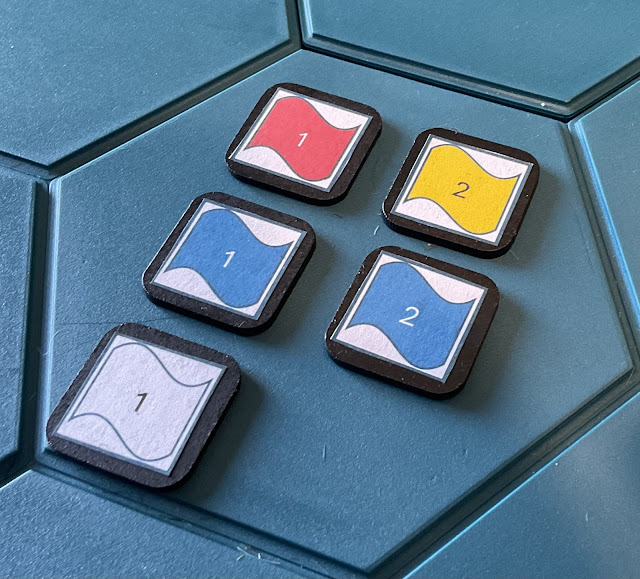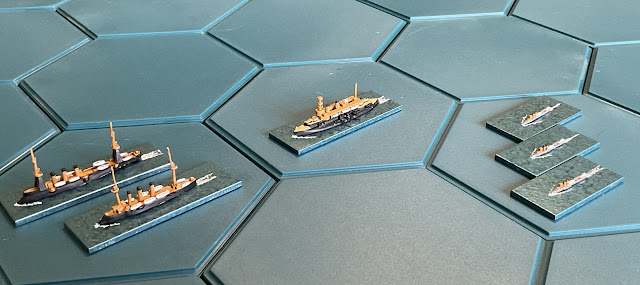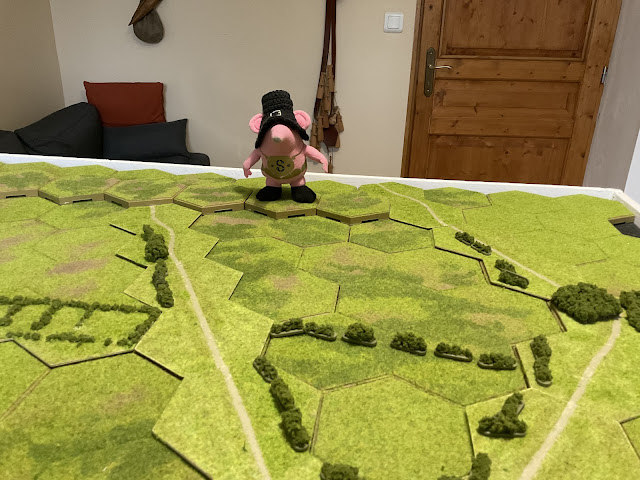After a few sessions of F2F testing against Jérémie it’ll come as no surprise to anyone that I dropped the flag orders portion of my homebrew naval rule set. They looked nice, they worked okay (ish) but they added extra and unnecessary “chrome” that the game seems none the worse without. I’m sure that most of those who write their own rules will have experienced something similar at one time or another.
Since everything else seemed ticketyboo and was explainable to a Frenchman (through the medium of dance when my French failed me) I’ve moved forward with my alt history Mediterranean naval campaign.
For those who can’t recall the setting and are too lazy to go back a post, the French and the Austrians have had a fallout over France’s attempt to control Morocco. Supporting Germany’s secret plan to provide troops for the Sultan’s defence an Austrian troop transport hits a mine and is lost with all hands. Shortly after and perhaps in retaliation a French merchant ship disappears off the coast of Albania.
Both sides demand satisfaction and the calling of a second international convention to arbitrate the matter. Unfortunately, before the convention can be arranged the French navy begins boarding and searching Austrian flagged merchant ships in Moroccan waters.
Naturally it didn’t take too long for the Austrians to start organising convoys and adding escorts to deter the French, and equally naturally it didn’t take long before a miscalculation saw shots fired.
Wounded national pride meant that damage to two Austrian escort cruisers could not go unanswered and all thoughts of an international convention were kicked into the long grass as we start this campaign in July 1906 with the following fleet action plans.
Austria has opted to “send a message” by shelling a largely unpopulated area of French Corsica with two major warships. The battleship Habsburg and the Armoured Cruiser Kaiser Karl VI approach the coast which unknown to them is being patrolled by three Motor Torpedo Boats (Tempête, Orage and Cyclone).
The mission occurs in calm seas with good visibility (the Torpedo Boats would have had to return to port if rough seas had been rolled for) and one side of the board is designated as coastline. The bigger Austrian ships stand a chance of running aground if they get too close to the shallows but their mission is to get within the 8 hex range of their main guns and fire off three salvoes into French territory.
 |
| Sacré Bleu! |
By turn 4 the Orage has rigged a temporary rudder repair but her sister ships have now closed in on the bigger vessels and as one they launch their torpedos.
Ignoring the sporadic and inaccurate gunfire from the Kaiser Karl the Tempête closes again to launch its last torpedo salvo - with devastating results.
 |
| This time the hits on the Kaiser Karl are terminal and she rolls over and sinks with huge loss of life. |
 |
| The Kaiser Karl’s damage capacity is maxed out and she sinks. |
I think I can safely chalk this game up as a French win which’ll score them 5 campaign points. With only 1 damage counter each the Torpedo Boats will be repairable within this 1 month window and available for missions in August. The Habsburg will make it home at half speed and will also during the month be repaired in time for actions in August. I suspect that the Captain will face an enquiry if not for the outcome then for not attempting to rescue the Kaiser Karl survivors!
Observations.
The Austrian ships were more heavily armed but slower and less manoeuvrable than the tiny French Torpedo Boats and this advantage allowed the French boats to press home their attacks with their very destructive torpedoes. The bottle out mechanism allowed for a realistic “time to get out of Dodge” moment for both fleets so that was all good too.
The failures, if failure they were, were out of the players hands. Anything but a calm weather environment roll would have forced the Torpedo Boats back to port before any combat, thereby ceding the game and the mission to the Austrians.
The Austrian decision to attack the French at long range alerted them to their presence. It’s unlikely the French boats would have just continued sailing along in ignorance until they left the board but if they had this would again have ceded the game to the Austrians.
A better die roll on the initial Austrian fire could have caused significant damage if it had hit, which would have altered the dynamic of the encounter at a stroke.
The assignment of vessels to missions by random die roll put the Austrians in an awkward spot. Attacking in daylight with two capital ships, unsupported by light screening vessels was a choice no competent Admiral should ever take. Another reason for a board of enquiry methinks!
All in all I was well chuffed. The game took 10 turns to complete and the playing time was a mere 50 minutes.
Hopefully I’ll have some wreck markers made before the next mission.
I appreciate that most of this blogs followers are not “naval types” but cheers if you’ve read this far. Take comfort that there’ll be a land based post coming up before the next maritime excursion.
Toodleooh.



















